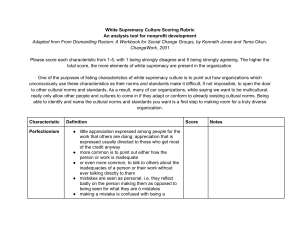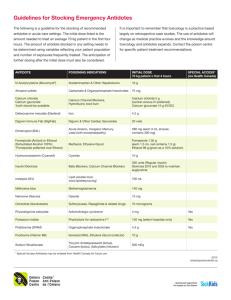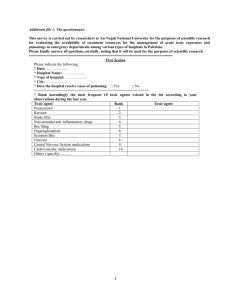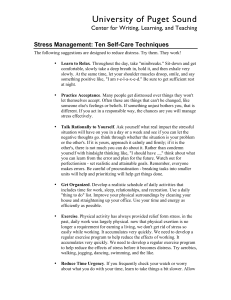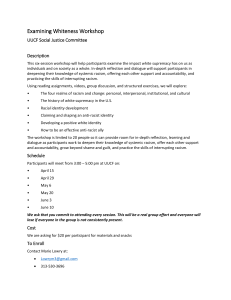White Supremacy Culture in Organizations: Characteristics & Antidotes
advertisement
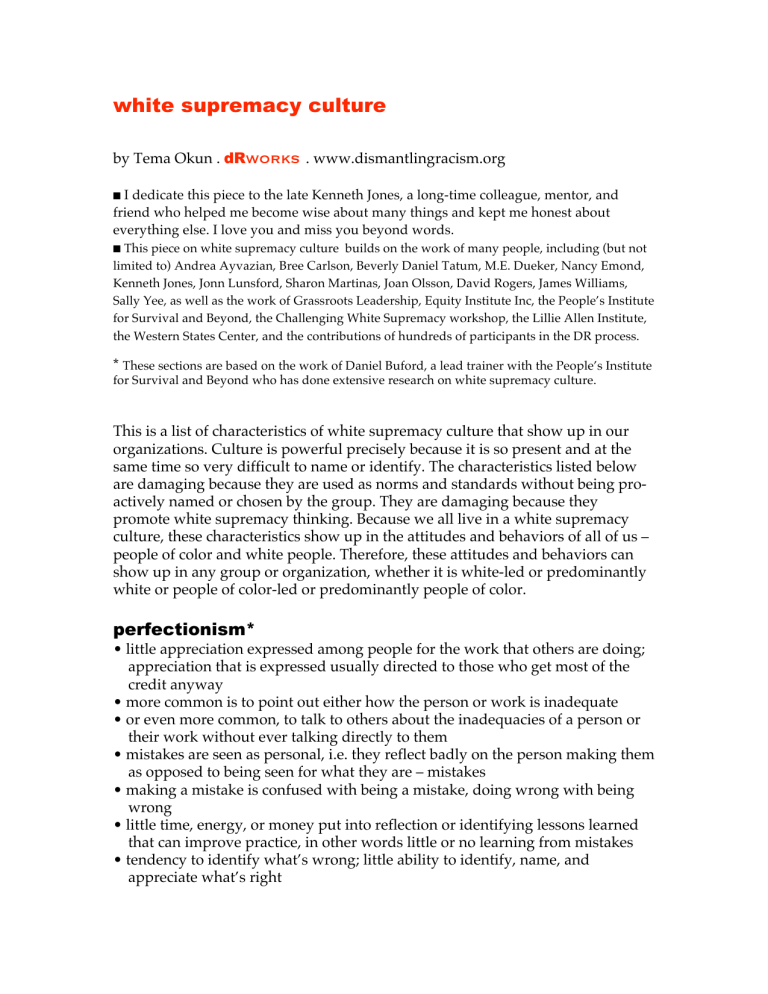
white supremacy culture by Tema Okun . dRworks . www.dismantlingracism.org I dedicate this piece to the late Kenneth Jones, a long-time colleague, mentor, and friend who helped me become wise about many things and kept me honest about everything else. I love you and miss you beyond words. ! This piece on white supremacy culture builds on the work of many people, including (but not limited to) Andrea Ayvazian, Bree Carlson, Beverly Daniel Tatum, M.E. Dueker, Nancy Emond, Kenneth Jones, Jonn Lunsford, Sharon Martinas, Joan Olsson, David Rogers, James Williams, Sally Yee, as well as the work of Grassroots Leadership, Equity Institute Inc, the People’s Institute for Survival and Beyond, the Challenging White Supremacy workshop, the Lillie Allen Institute, the Western States Center, and the contributions of hundreds of participants in the DR process. ! * These sections are based on the work of Daniel Buford, a lead trainer with the People’s Institute for Survival and Beyond who has done extensive research on white supremacy culture. This is a list of characteristics of white supremacy culture that show up in our organizations. Culture is powerful precisely because it is so present and at the same time so very difficult to name or identify. The characteristics listed below are damaging because they are used as norms and standards without being proactively named or chosen by the group. They are damaging because they promote white supremacy thinking. Because we all live in a white supremacy culture, these characteristics show up in the attitudes and behaviors of all of us – people of color and white people. Therefore, these attitudes and behaviors can show up in any group or organization, whether it is white-led or predominantly white or people of color-led or predominantly people of color. perfectionism* • little appreciation expressed among people for the work that others are doing; appreciation that is expressed usually directed to those who get most of the credit anyway • more common is to point out either how the person or work is inadequate • or even more common, to talk to others about the inadequacies of a person or their work without ever talking directly to them • mistakes are seen as personal, i.e. they reflect badly on the person making them as opposed to being seen for what they are – mistakes • making a mistake is confused with being a mistake, doing wrong with being wrong • little time, energy, or money put into reflection or identifying lessons learned that can improve practice, in other words little or no learning from mistakes • tendency to identify what’s wrong; little ability to identify, name, and appreciate what’s right dRworks . wwwdismantlingracism.org . page 2 • often internally felt, in other words the perfectionist fails to appreciate her own good work, more often pointing out his faults or ‘failures,’ focusing on inadequacies and mistakes rather than learning from them; the person works with a harsh and constant inner critic antidotes: develop a culture of appreciation, where the organization takes time to make sure that people’s work and efforts are appreciated; develop a learning organization, where it is expected that everyone will make mistakes and those mistakes offer opportunities for learning; create an environment where people can recognize that mistakes sometimes lead to positive results; separate the person from the mistake; when offering feedback, always speak to the things that went well before offering criticism; ask people to offer specific suggestions for how to do things differently when offering criticism; realize that being your own worst critic does not actually improve the work, often contributes to low morale among the group, and does not help you or the group to realize the benefit of learning from mistakes sense of urgency • continued sense of urgency that makes it difficult to take time to be inclusive, encourage democratic and/or thoughtful decision-making, to think long-term, to consider consequences • frequently results in sacrificing potential allies for quick or highly visible results, for example sacrificing interests of communities of color in order to win victories for white people (seen as default or norm community) • reinforced by funding proposals which promise too much work for too little money and by funders who expect too much for too little antidotes: realistic workplans; leadership which understands that things take longer than anyone expects; discuss and plan for what it means to set goals of inclusivity and diversity, particularly in terms of time; learn from past experience how long things take; write realistic funding proposals with realistic time frames; be clear about how you will make good decisions in an atmosphere of urgency; realize that rushing decisions takes more time in the long run because inevitably people who didn’t get a chance to voice their thoughts and feelings will at best resent and at worst undermine the decision because they were left unheard defensiveness • the organizational structure is set up and much energy spent trying to prevent abuse and protect power as it exists rather than to facilitate the best out of each person or to clarify who has power and how they are expected to use it • because of either/or thinking (see below), criticism of those with power is viewed as threatening and inappropriate (or rude) • people respond to new or challenging ideas with defensiveness, making it very difficult to raise these ideas • a lot of energy in the organization is spent trying to make sure that people’s feelings aren’t getting hurt or working around defensive people • white people spend energy defending against charges of racism instead of examining how racism might actually be happening • the defensiveness of people in power creates an oppressive culture antidotes: understand that structure cannot in and of itself facilitate or prevent abuse; understand the link between defensiveness and fear (of losing power, losing face, losing comfort, losing privilege); work on your own defensiveness; name defensiveness as a problem when it is one; give people credit for being able to handle more than you think; discuss the ways in which defensiveness or resistance to new ideas gets in the way of the mission quantity over quality* • all resources of organization are directed toward producing measurable goals • things that can be measured are more highly valued than things that cannot, for example numbers of people attending a meeting, newsletter circulation, money spent are valued more than quality of relationships, democratic decision-making, ability to constructively deal with conflict • little or no value attached to process; if it can’t be measured, it has no value • discomfort with emotion and feelings • no understanding that when there is a conflict between content (the agenda of the meeting) and process (people’s need to be heard or engaged), process will prevail (for example, you may get through the agenda, but if you haven’t paid attention to people’s need to be heard, the decisions made at the meeting are undermined and/or disregarded) antidotes: include process or quality goals in your planning; make sure your organization has a values statement which expresses the ways in which you want to do your work; make sure this is a living document and that people are using it in their day to day work; look for ways to measure process goals (for example if you have a goal of inclusivity, think about ways you can measure whether or not you have achieved that goal); learn to recognize those times when you need to get off the agenda in order to address people’s underlying concerns worship of the written word • if it’s not in a memo, it doesn’t exist • the organization does not take into account or value other ways in which information gets shared • those with strong documentation and writing skills are more highly valued, even in organizations where ability to relate to others is key to the mission antidotes: take the time to analyze how people inside and outside the organization get and share information; figure out which things need to be written down and come up with alternative ways to document what is happening; work to recognize the contributions and skills that every person brings to the organization (for example, the ability to build relationships with dRworks . wwwdismantlingracism.org . page 4 those who are important to the organization’s mission); make sure anything written can be clearly understood (avoid academic language, ‘buzz’ words, etc.) only one right way • the belief there is one right way to do things and once people are introduced to the right way, they will see the light and adopt it • when they do not adapt or change, then something is wrong with them (the other, those not changing), not with us (those who ‘know’ the right way) • similar to the missionary who does not see value in the culture of other communities, sees only value in their beliefs about what is good antidotes: accept that there are many ways to get to the same goal; once the group has made a decision about which way will be taken, honor that decision and see what you and the organization will learn from taking that way, even and especially if it is not the way you would have chosen; work on developing the ability to notice when people do things differently and how those different ways might improve your approach; look for the tendency for a group or a person to keep pushing the same point over and over out of a belief that there is only one right way and then name it; when working with communities from a different culture than yours or your organization’s, be clear that you have some learning to do about the communities’ ways of doing; never assume that you or your organization know what’s best for the community in isolation from meaningful relationships with that community paternalism • decision-making is clear to those with power and unclear to those without it • those with power think they are capable of making decisions for and in the interests of those without power • those with power often don’t think it is important or necessary to understand the viewpoint or experience of those for whom they are making decisions • those without power understand they do not have it and understand who does • those without power do not really know how decisions get made and who makes what decisions, and yet they are completely familiar with the impact of those decisions on them antidotes: make sure that everyone knows and understands who makes what decisions in the organization; make sure everyone knows and understands their level of responsibility and authority in the organization; include people who are affected by decisions in the decision-making either/or thinking* • things are either/or — good/bad, right/wrong, with us/against us • closely linked to perfectionism in making it difficult to learn from mistakes or accommodate conflict • no sense that things can be both/and • results in trying to simplify complex things, for example believing that poverty is simply a result of lack of education • creates conflict and increases sense of urgency, as people feel they have to make decisions to do either this or that, with no time or encouragement to consider alternatives, particularly those which may require more time or resources • often used by those with a clear agenda or goal to push those who are still thinking or reflecting to make a choice between ‘a’ or ‘b’ without acknowledging a need for time and creativity to come up with more options antidotes: notice when people use ‘either/or’ language and push to come up with more than two alternatives; notice when people are simplifying complex issues, particularly when the stakes seem high or an urgent decision needs to be made; slow it down and encourage people to do a deeper analysis; when people are faced with an urgent decision, take a break and give people some breathing room to think creatively; avoid making decisions under extreme pressure power hoarding • little, if any, value around sharing power • power seen as limited, only so much to go around • those with power feel threatened when anyone suggests changes in how things should be done in the organization, feel suggestions for change are a reflection on their leadership • those with power don’t see themselves as hoarding power or as feeling threatened • those with power assume they have the best interests of the organization at heart and assume those wanting change are ill-informed (stupid), emotional, inexperienced antidotes: include power sharing in your organization’s values statement; discuss what good leadership looks like and make sure people understand that a good leader develops the power and skills of others; understand that change is inevitable and challenges to your leadership can be healthy and productive; make sure the organization is focused on the mission fear of open conflict • people in power are scared of expressed conflict and try to ignore it or run from it • when someone raises an issue that causes discomfort, the response is to blame the person for raising the issue rather than to look at the issue which is actually causing the problem • emphasis on being polite • equating the raising of difficult issues with being impolite, rude, or out of line antidotes: role play ways to handle conflict before conflict happens; distinguish between being polite and raising hard issues; don’t require those dRworks . wwwdismantlingracism.org . page 6 who raise hard issues to raise them in ‘acceptable’ ways, especially if you are using the ways in which issues are raised as an excuse not to address those issues; once a conflict is resolved, take the opportunity to revisit it and see how it might have been handled differently individualism* • little experience or comfort working as part of a team • people in organization believe they are responsible for solving problems alone • accountability, if any, goes up and down, not sideways to peers or to those the organization is set up to serve • desire for individual recognition and credit • leads to isolation • competition more highly valued than cooperation and where cooperation is valued, little time or resources devoted to developing skills in how to cooperate • creates a lack of accountability, as the organization values those who can get things done on their own without needing supervision or guidance antidotes: include teamwork as an important value in your values statement; make sure the organization is working towards shared goals and people understand how working together will improve performance; evaluate people’s ability to work in a team as well as their ability to get the job done; make sure that credit is given to all those who participate in an effort, not just the leaders or most public person; make people accountable as a group rather than as individuals; create a culture where people bring problems to the group; use staff meetings as a place to solve problems, not just a place to report activities i’m the only one • connected to individualism, the belief that if something is going to get done right, ‘I’ have to do it • little or no ability to delegate work to others antidotes: evaluate people based on their ability to delegate to others; evaluate people based on their ability to work as part of a team to accomplish shared goals progress is bigger, more* • observed in how we define success (success is always bigger, more) • progress is an organization which expands (adds staff, adds projects) or develops the ability to serve more people (regardless of how well they are serving them) • gives no value, not even negative value, to its cost, for example, increased accountability to funders as the budget grows, ways in which those we serve may be exploited, excluded, or underserved as we focus on how many we are serving instead of quality of service or values created by the ways in which we serve antidotes: create Seventh Generation thinking by asking how the actions of the group now will affect people seven generations from now; make sure that any cost/benefit analysis includes all the costs, not just the financial ones, for example the cost in morale, the cost in credibility, the cost in the use of resources; include process goals in your planning, for example make sure that your goals speak to how you want to do your work, not just what you want to do; ask those you work with and for to evaluate your performance objectivity* • the belief that there is such a thing as being objective or ‘neutral’ • the belief that emotions are inherently destructive, irrational, and should not play a role in decision-making or group process • invalidating people who show emotion • requiring people to think in a linear (logical) fashion and ignoring or invalidating those who think in other ways • impatience with any thinking that does not appear ‘logical’ antidotes: realize that everybody has a world view and that everybody’s world view affects the way they understand things; realize this means you too; push yourself to sit with discomfort when people are expressing themselves in ways which are not familiar to you; assume that everybody has a valid point and your job is to understand what that point is right to comfort • the belief that those with power have a right to emotional and psychological comfort (another aspect of valuing ‘logic’ over emotion) • scapegoating those who cause discomfort • equating individual acts of unfairness against white people with systemic racism which daily targets people of color antidotes: understand that discomfort is at the root of all growth and learning; welcome it as much as you can; deepen your political analysis of racism and oppression so you have a strong understanding of how your personal experience and feelings fit into a larger picture; don’t take everything personally One of the purposes of listing characteristics of white supremacy culture is to point out how organizations which unconsciously use these characteristics as their norms and standards make it difficult, if not impossible, to open the door to other cultural norms and standards. As a result, many of our organizations, while saying we want to be multi-cultural, really only allow other people and cultures to come in if they adapt or conform to already existing cultural norms. Being able to identify and name the cultural norms and standards you want is a first step to making room for a truly multi-cultural organization. dRworks . wwwdismantlingracism.org . page 8 Partial Bibliography: Notes from People’s Institute for Survival and Beyond Workshop, Oakland, CA, spring 1999. Notes from Challenging White Supremacy Workshop, San Francisco, CA, spring 1999. Beverly Daniel Tatum, Why Are All the Black Kids Sitting Together in the Cafeteria? NY: HarperCollins, 1997. Derrick Jensen, A Language Older Than Words. NY: Context Books, 2000. Paul Kivel, Uprooting Racism. PA: New Society Publishers, 1996. Anne Wilson Schaef, Living in Process. NY: Ballantine, 1998. For complete bibliography, see complete notebook for dRwork’s Dismantling Racism process. dRworks is a group of trainers, educators and organizers working to build strong progressive anti-racist organizations and institutions. dRworks can be reached at www.dismantlingracism.org.
